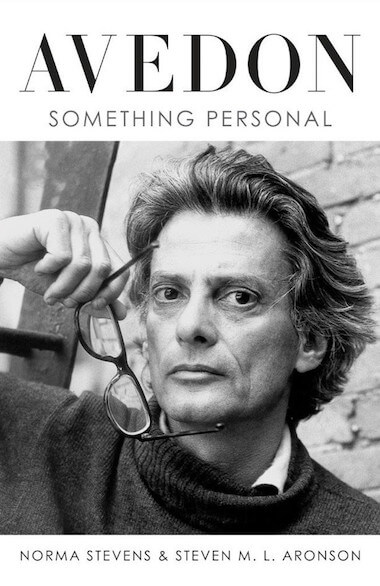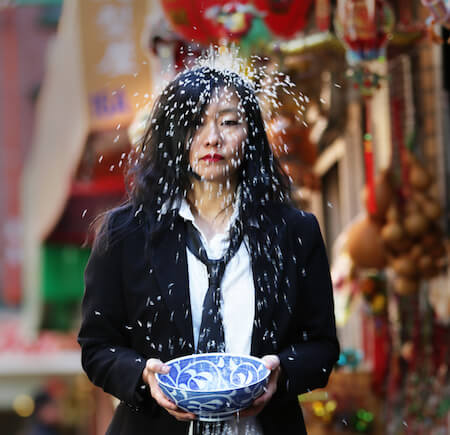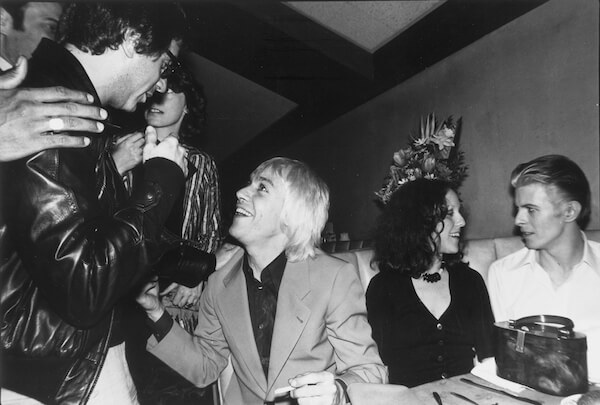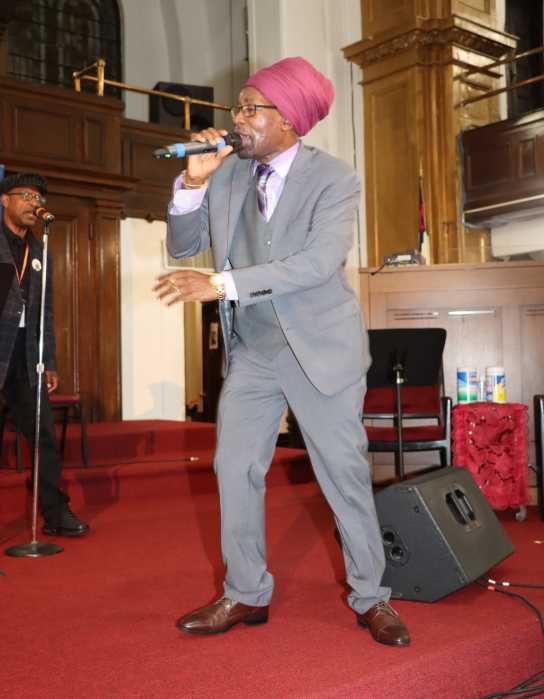Album cover shoot for “Aladdin Sane,” 1973. | PHOTO DUFFY/ © DUFFY ARCHIVE & THE DAVID BOWIE ARCHIVE / GAY CITY NEWS COVER DESIGN BY MARCOS RAMOS
BY DAVID NOH | I somehow remember David Bowie’s 1979 appearance on “Saturday Night Live” as if it were yesterday, for it was a pretty defining moment in my life. I was getting ready to go out for my basic Saturday evening revels, which, back then, involved what to me now seems a bewildering and exhausting agenda of people and places, which might change superficially, depending on certain new places opening, as they seemed to do with spectacular regularity in those heady days, but always included three staples, in this order: Studio 54 first, for sheer glam and celeb spotting, the Mudd Club, for a New Wave punk respite from all that glossy disco (and also for those inevitable hot nook sessions in the always teeming loo, where those straight boyz in skinny jeans and ties always seemed to escape from their girlfriends), and, lastly, the Paradise Garage, for the deep, elemental funk — better than any high to be found in my admittedly full pockets — where they would have to sweep me out with the garbage noon Sunday.
David Bowie in 1966. | DOUGH MCKENZIE/ COURTESY OF THE DAVID BOWIE ARCHIVE
So, there I was, trying to put an outfit (and my party head) together, with the TV on, when I saw it. Or them, I should say: David Bowie, in a Thierry Mugler dress, singing “TVC 15,” backed by avant-garde downtown denizens Joey Arias and Klaus Nomi — also in drag — doing their then revolutionary semaphoric hand gestures.
I frankly lost it, because you have to understand, this was a time when music and pop entertainment were as strictly segregated, culturally, as those clubs I mentioned. Sure, Joey, as we all knew, had a day job selling fluorescent merch at trend-central Fiorucci on East 59th Street, but he, like Nomi, was strictly downtown, freaky and decidedly not mainstream, so to see the two of them on “Saturday Night Life” felt like both a severe transgression as well as some kind of glorious recognition (and validation) of, well, us, and all kinds of gay stuff that would wait decades before even being considered fit for public consumption or discussion.
Brooklyn Museum celebrates the art and many identities of David Bowie
Bowie in a 1966 publicity photo for the Kon-rads. | ROY AINSWORTH/ COURTESY OF THE DAVID BOWIE ARCHIVE/ IMAGE © VICTORIA AND ALBERT MUSEUM
And Bowie, of course, was responsible for this startling subversiveness, having plucked these queer as-yet-unknown novas from relative obscurity and thrown them in the face of an America he no doubt felt should have been more than ready already for them. He then followed this number up, later in the program, with what became my instant anthem, “Boys Keep Swinging,” with those joyous lyrics, “When you’re a boy you can wear a uniform, when you’re a boy other boys check you out…” Those words had the effect of making me — and an entire gay generation — feel mighty real, and damn sexy, ready to go out and triumph. Which I did that night — in a party sense — while hearing it played at various venues, all evening long.
Bowie in 1973. | MASAYOSHI SUKITA/ © SUKITA/ THE DAVID BOWIE ARCHIVE
Bowie’s estate opened its vast archive for this show, and we can only thank God that the man was a true hoarder. Something like 400 objects here include costumes of all his myriad personas, from Ziggy to the Thin White Duke, New Wave rocker to disco king, with especially memorable collaborations with Kansai Yamamoto and Alexander McQueen, who made that masterpiece of a tattered Union Jack frock coat Bowie sported with such aplomb. You will see original lyric sheets, album art, full music videos (including that “Saturday Night Live” appearance), photographs galore from his music and stage appearances (an intriguing-looking production of Brecht’s “Baal,” as well as his celebrated “Elephant Man” on Broadway), clips and memorabilia from his movies, including Nicholas Roeg’s haunting “The Man Who Fell to Earth.”
Bowie with William Burroughs in 1974. |PHOTOGRAPH BY TERRY O’NEILL WITH COLOR BY DAVID BOWIE/ COURTESY OF THE DAVID BOWIE ARCHIVE/ IMAGE © VICTORIA AND ALBERT MUSEUM
That film was the inspiration for his final major artistic effort, the stage production of “Lazarus,” one of the finest achievements of his career, built around a compendium of his songs, which had all the eeriness of the Roeg movie, but also morphed into a moving celebration of the happiness he found in New York, with his new family, second wife Iman, the supermodel, and their daughter. Iman, statuesque and agelessly gorgeous, was actually at the performance I attended at New York Theatre Workshop, but even more arresting was a certain feeling that permeated the entire theater during the performance. I experienced it not only as a visceral reaction to the music and ingeniously dramatic staging by Ivo van Hove, but in a deeply emotional sense, as well.
Michael C. Hall’s brilliant performance echoed Bowie’s original dramatic template while also summoning up oceans of existential foreboding and fatalism that felt like a punch in the chest. I found myself tearing up a lot at odd moments, and not long after that, Bowie died of the liver cancer about which he had kept quiet, and it was almost as if his very spirit, leaving this earth he had so enriched and — in his way — changed, had permeated this space with a particularly heavy and sorrowful leavetaking. I have never experienced anything like this in the theater nor do I expect I ever will again.
Bowie in 1976. | ANDY KENT/ COURTESY OF THE DAVID BOWIE ARCHIVE
Walking through the Brooklyn Museum show, something else struck me, and indeed, it should anyone else with any kind of consciousness, and that was how gay it is. There is all that androgynous drag, including more than a few dresses, as well as ladies’ accessories, early film footage of him in extreme maquillage, having his nails painted with glitter as clueless English schoolgirls went apeshit over him, and all kinds of homoeroticism in his many quite accomplished drawings on display. Hell, there was even a full-scale oil portrait he did during a period in which he used painting as therapy to recover from drugs, the subject being Yukio Mishima. Also quite telling, amusing, and prescient was a cartoon depicting him in his youthful, androgynous heyday, torn between using a male or female loo, presaging the queer identity wars going on right now.
The original photography for the “Earthling” album cover, 1997, in which Bowie wore a tattered Union Jack frock designed by Alexander McQueen. | FRANK W OCKENFELS 3/ © FRANK W OCKENFELS 3
Happily, this show does not minimize or camouflage this actually quite benign sexual elephant in the room, even including his 1972 quote to journalist Michael Watts, “I’m gay, and always have been, even when I was David Jones,” his birth name. He later retracted this in 1983, a far more conservative time than the 1970s, in which closet doors were slamming shut again due to AIDS, and Elton John and Calvin Klein were getting married. He called the 1972 statement “the biggest mistake I ever made” in Rolling Stone magazine. In the big picture, it’s really a relatively small matter when one considers the generations of gay and otherwise-identified “different” kids who found both inspiration and support in his work, possessing, as it does, a truly inspiriting, universal appeal.
DAVID BOWIE IS | Brooklyn Museum, 200 Eastern Parkway at Washington Ave., near Grand Army Plaza | Through Jul. 15: Wed., Fri.-Sun., 11 a.m.-6 p.m.; Thu., 11 a.m.-10 p.m. | $16; $10 for students & seniors at brooklynmuseum.org
A 1972 quilted two-piece suit designed by≈for Bowie’s “Ziggy Stardust” tour. | THE DAVID BOWIE ARCHIVE/ IMAGE © VICTORIA AND ALBERT MUSEUM







































